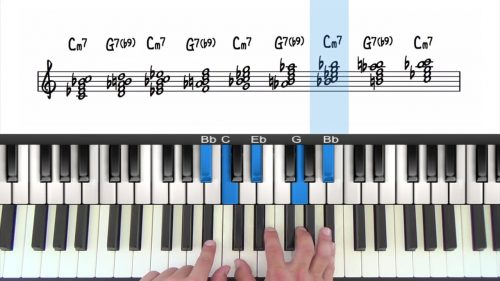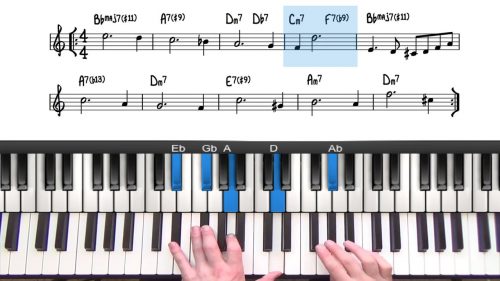My Favourite Things Tutorial
In this lesson we’re going to create a solo piano arrangement for the tune “My Favourite Things”.
The tune is written in ¾ so it’s played with a waltz feel. We do interpret some of the tune quite freely, in particular in the introduction and the ending.
I’ve drawn inspiration from 2 different areas and styles. Firstly the Bill Evans solo piano recording is a great place to start with this tune. He makes great use of the different registers of the piano which you will see in this arrangement.
I’ve also absorbed some of the style and phrasing of contemporary players such as the jazz prodigy joey alexander and his brilliant rendition of this tune.
We apply lots of quartal voicings and rehamonisations which give parts of the arrangement a fresh and modern sound.
Practice Tips
-
This lesson demonstrates the options available to bring interest to simple or repetitive chord progressions.
-
First we look at the minor line cliche which always sounds great over minor chords.
-
Next we look at moving the inner voices of the chord by taking the 5th up to the #5, then to the 6th and finally to the minor 7th.
- Also look out for melody lines that move up the notes of a scale, this gives you the opportunity to harmonise the line with the diatonic 7th chords of the key. In this lesson we demonstrate this with diatonic drop 2 voicings.







Thanks for an excellent lesson, Hayden, and the new site with its logical layout appears to work well too. I may have missed it but is there a list of all lessons? Also will you be providing transcriptions for this lesson since I haven’t discovered a good way of notating your voicings to allow easy reading whilst playing? Perhaps others could enlighten me on their method. Thanks for all your hard work.
Brian.
Thanks Brian… glad you like the arrangement.
Yes I will be providing a transcription for this lesson… the arrangement is played very freely in the beginning and the end, making it tricky to notate but I will find away around this. Give me a few days with this :-)
Cheers,
Hayden
ps. I use Sibelius for transcriptions. The output is great, but it’s very fiddly to use! 😄
I noticed you were going to do a transcription for this a while back, but I couldn’t locate it. Is there one? Thanks
Hi John,
This arrangement is played very freely and so it’s difficult to notate.
Perhaps it would be possible to outline the chord voicings as a reference.
Leave it with me and I’ll see what I can do.
Cheers!
Hayden
I ended up printing the chord sheet and adding your beautiful voicings. So no worries.
Awesome, I think that’s the best solution John.
Enjoy the lessons!
Hayden
Hi Hayden – may I ask – are you using much sustain pedal in this or any at all? I think I’ve developed a bad habit by playing notes staccato and using the sustain to compensate for this. Should I be keeping my fingers on the keys for longer and not using pedal? Any tips appreciated.
Hi Eoin,
Yes I do use a lot of sustain pedal in this arrangement; more so than in other lessons. I do use the sustain pedal in most of my ballad arrangements for your information.
In parts of this arrangement there are big leaps between the chord voicings that I play and it would be very difficult to connect these smoothly without using the sustain pedal.
What I would recommend Eoin is not using too much pedal when the right hand is playing the melody. When playing right hand melody lines, too much pedal can ‘blur’ together the notes. When we are playing solo piano it’s important that we play the melody clearly and cleanly.
To answer your question: try to keep your fingers on the keys when the right hand melody is playing the melody and aim to play your melody notes legato (which means smoothly and joined together). For the big jumps in between the chords, we must lift our hands up, and that is when we can rely on the pedal to create a smooth effect.
Hope this helps!
Cheers,
Hayden
Found the lesson very helpful as ever. On the face of it, not the most exciting chord changes, but deploying your suggestions solves that problem. Obviously suits the out and out modal specialists, less so if one feels more comfortable with a typical GASB structure.
Two questions for you.
In jazz, has it become the norm to miss out the sixteen bar sequence immediately after the repeated A section in the original composition? The one starting with a major chord not minor?iReal does include it.
I love some of the voicings used, but despite much acrobatic work, tapping the screen, very difficult to identify the notes used. Is there a knack? Is there a transcription?
As I said though, a very helpful lesson. Thank you. Ed
Hi Ed 👋
Glad you enjoyed the lesson and good questions.
Regarding the 16 bar sequence in the original composition, there are many ways to arrange the tune, as with all jazz tunes. This isn’t a tune I play regularly but I did have fun arranging it. To create the arrangement I was listening to various versions on YouTube and Spotify and using my knowledge of jazz harmony. By no means is this a definitive arrangement. If you like that additional section, it would be a worthwhile exercise to find some recordings that contain that part of the tune and use them for inspiration.
For your second question, no I didn’t create a transcription. I play the tune very freely, and so it would be difficult to notate in a meaningful and useful format.
We do have a ’10 second skip back button’ which is in the bottom left of the video player right next to the play button. This is the most efficient way to skip back in small increments to try to catch the chord or voicing. This is a lot less fiddly than using the scroll bar to rewind.
You can see a full demo of our video controls here, if you haven’t already seen the video: pianogroove.com/community/t/how-to-use-the-video-player/2458/
Hope this helps Ed, and if I can be of further assistance just let me know.
Cheers,
Hayden
Gracias, es una de mis favoritas canciones y me gusto mucho más con su interpretación. Y como siempre, desde que lo sigo en YouTube, sus explicaciones son muy buenas y eso que el ingles no es mi idioma. Sin duda lo recomendaría a cualquier persona que desee aprender a tocar el piano.